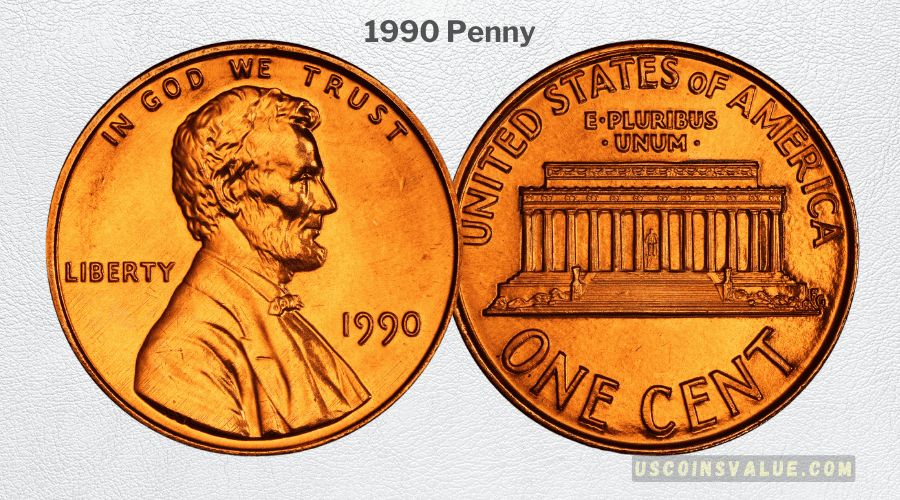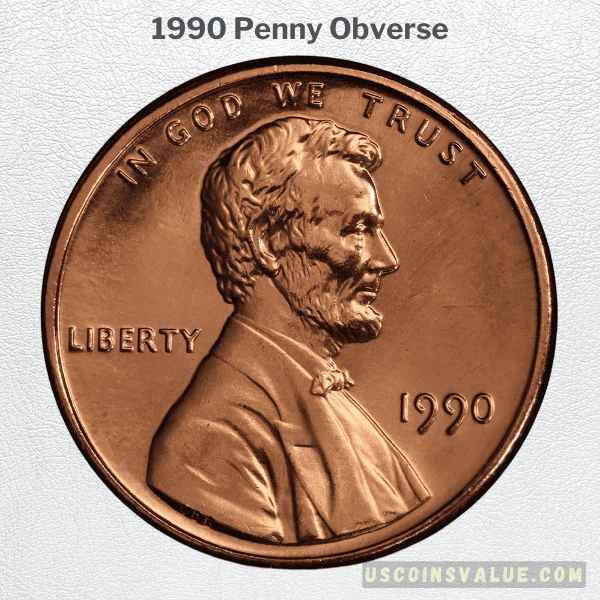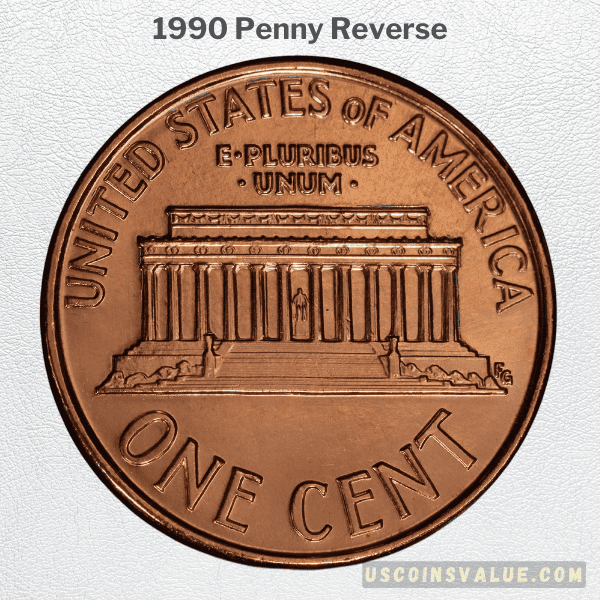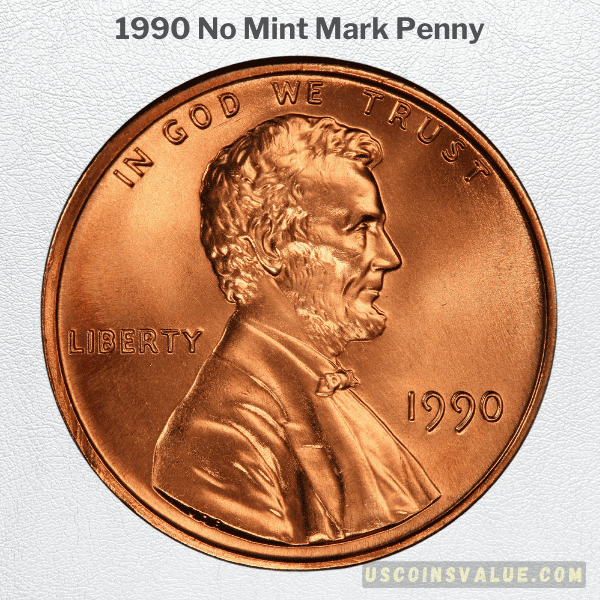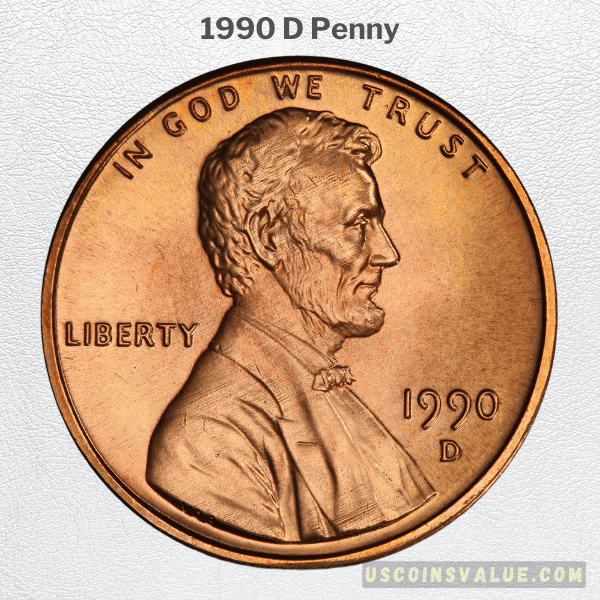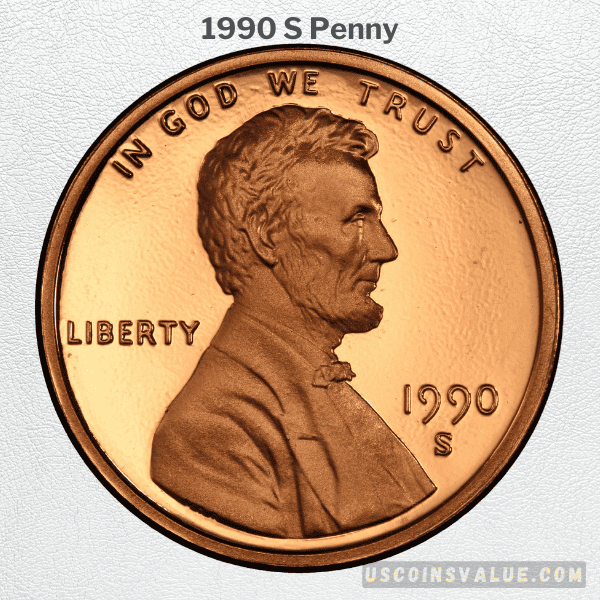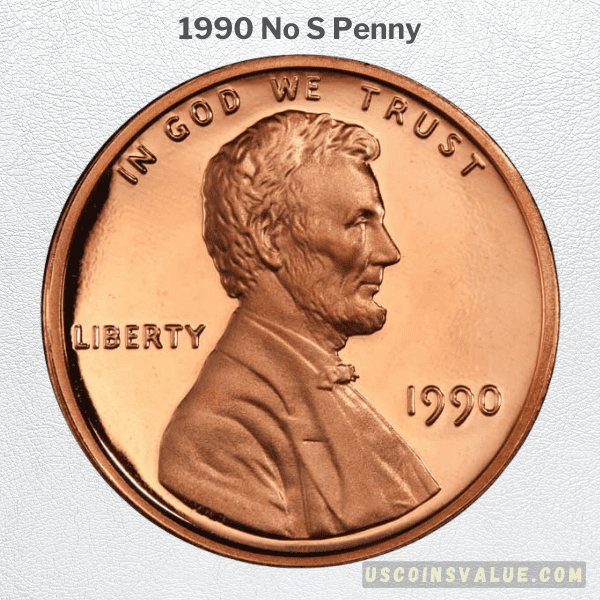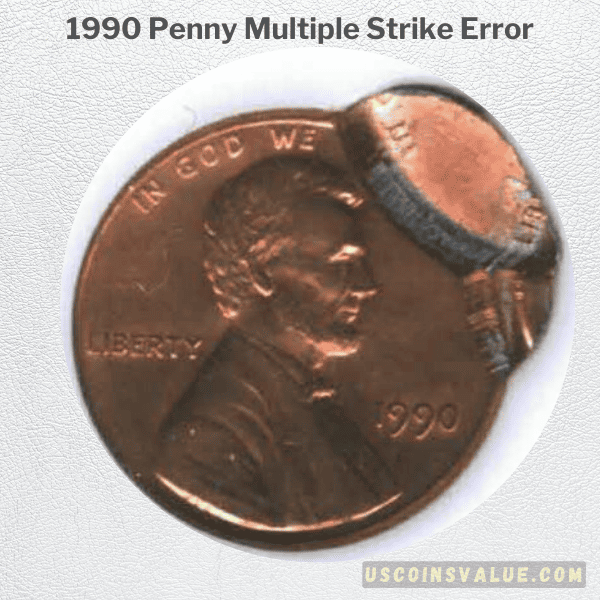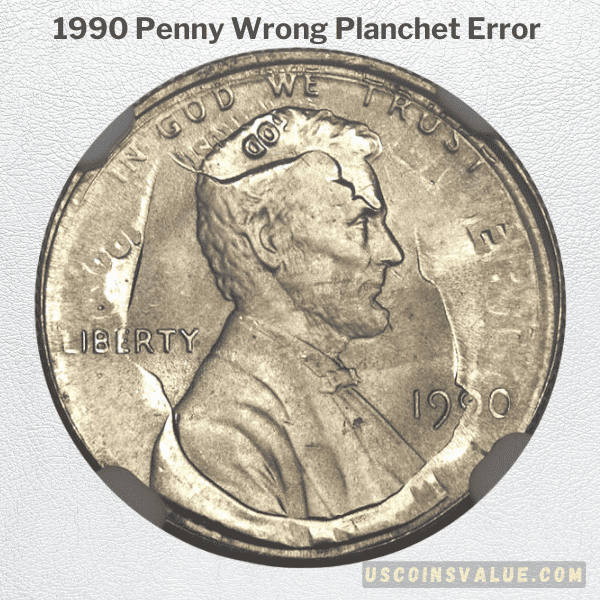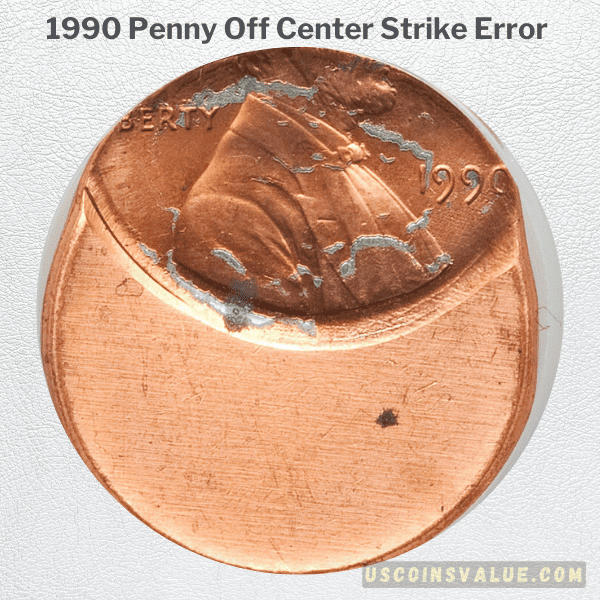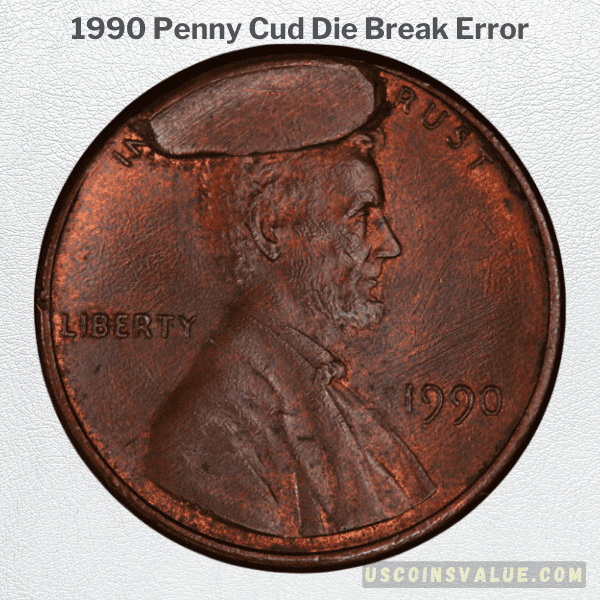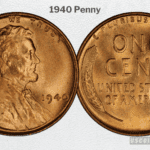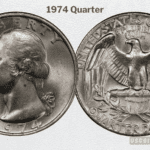Let me take a guess, you’ve recently come across a 1990 Penny, you are wondering if in the numismatic world it’s worth more than its face value of one cent or what conditions determine the value of this coin?
These questions and more will be answered in the course of this article. We’ll provide valuable information on the 1990 Lincoln cent and show you how to evaluate the value of this penny that’s a little over 3-decades old.
It’s worth stating that several 1990 Lincoln pennies in today’s market are worth more than their face value. A typical Mint State regular strike or pristine Proof 1990 penny will cost you between $5 – $5.84.
The price can also soar high as a PR69 No S variant of this coin sold for an auction record of $20,700 in 2007
Keep reading to learn everything about the 1990 Penny variants, value, and errors that could fetch you money today.
What is the Background of the 1990 Penny?
The 1990 penny belongs to the new Lincoln Memorial series that replaced the Lincoln/Wheat design by Victor David Brenner. Frank Gasparro redesigned the reverse side of this coin Cent.
Gasparro’s reverse features the Lincoln Memorial building in honor of the late President’s 150th birthday anniversary. This new design lasted 48 years, from 1959 until 2008.
As the first year in the last decade of the 20th century, the 1990 penny holds sentimental value for numismatics. It also had some rare errors that became coveted.
Before we get to that, let’s discuss the features on the 1990 penny. It’ll help you identify what’s missing on the special variants.
The 1990 Penny Features
- Series: Lincoln
- Year of Make: 1990
- Mintage: 6,851,765,000
- Mint Branch: Philadelphia
- Composition: Copper-Plated Zinc (97.5% Zinc and 2.5% Copper)
- Weight: 2.5g
- Diameter: 19 mm
- Edge: Plain
Obverse & Reverse Design
An engraving of Lincoln’s upper body in a side profile facing right is at the center of the 1990 penny’s obverse. The “obverse” is the front or head position, while the background is the “field.” Lincoln’s image has a full head of hair and beard.
The image stops at his upper body, showing his suit jacket, inner shirt, and bowtie. Other details on the field include:
- IN GOD WE TRUST
- LIBERTY
- 1990
- Mint Mark
The details Gasparro designed on the reverse side are:
- UNITED STATES OF AMERICA
- PLURIBUS. UNUM
- Lincoln Memorial
- FG
- ONE CENT
What are the 1990 Penny Varieties?
In 1990, there were three major penny varieties, including the Regular Strikes from Philadelphia and Denver and the San Francisco Proof coins.
A fourth variety arose when the Philadelphia Mint mistakenly placed Proof sets in its machines, leading to the 1990 No S penny. So, the 1990 No S penny is part of the mintage meant for the 1990-S Proof pennies. This is the reason for the similarity in the number of coins minted.
| 1990 (Lincoln) Varieties | Mint Location | Mintage |
| Regular Strike | Philadelphia | 6,851,765,000 |
| 1990-D Regular Strike | Denver | 4,922,894,533 |
| 1990-S Proof | San Francisco | 3,299,559 |
| 1990 No S Proof | Philadelphia | 3,299,559 |
1990 Penny (No Mint Mark)
Every 1990 Penny without a mint mark came from Philadelphia because it was the principal minting facility in the USA. However, when Denver and San Francisco started minting 1990 pennies, Philadelphia added “P” mint marks to distinguish its coins from the rest.
The 1990 regular strike penny with no mint mark had the most mintage at over 6 billion. It also explains why it’s still available in the open market and commanding high price values in its high-grade Mint State.
1990-D Penny
Denver-minted 1990 pennies came with a small “D” underneath “1990” on the coin’s obverse. They had the same 2.5% Copper plated over 97.5% Zinc composition as the regular strike 1990 pennies from Philadelphia.
The 1990-D penny is the second-highest mintage, with almost 5 billion pieces.
1990-S Penny (DCAM)
Before a minting facility strikes a coin for circulation, it tests the design with Proof coins. This variant has a different manufacturing process involving fresh dies and planchets. So, the Proof pennies come out shinier and more defined than the regular strikes.
The San Francisco mint exclusively designed the 1990 Proof pennies with a Deep Cameo luster and an “S” mint mark on the obverse to identify the facility.
1990 No S Penny (CAM & DCAM)
The Philadelphia-minted proof coins didn’t have the required “S” mint mark because it wasn’t part of the facility’s standard minting machine. However, all other features were intact.
The DCAM No S 1990 pennies have a brown-black field, while the engravings are a bright copper shade, unlike the CAM proof that is purely copper-toned.
The exact number of “No S” 1990 pennies remains unknown, but they’re part of the San Francisco-proof one-cent coins from that year. Hence, the recorded mintage for 1990 proof coins stands at 3,299,559.
What’s the Current Value of the 1990 Penny?
You can buy an average quality 1990 penny for as low as $0.34, making them an affordable collection series. But if you want the Proof CAM and DCAM variants, it’ll set you back at least $5.84. Prepare to spend as much as $2,000 – $3,395 for a “No S” 1990 proof penny.
Here’s a table showing the price range for Mint State and PR 1990 pennies graded 60 – 70.
| 1990 Penny Grades | Regular Strike (No Mint Mark) | 1990-D Regular Strike | 1990-S Proof Cent | 1990 No S Proof Cent |
| 60 | – | – | 1 | – |
| 61 | – | – | 1 | – |
| 62 | 1 | – | 1 | – |
| 63 | 6 | 6 – 6 | 2 | 2,100 – 2,150 |
| 64 | 8 | 7 – 8 | 3 | 2,250 – 2,300 |
| 65 | 12 | 10 – 12 | 4 | 2,500 – 2,700 |
| 66 | 22 | 17 – 20 | 5 | 3250 – 3,350 |
| 67 | 90 | 28 – 55 | 6 | 3,600 – 3,800 |
| 68 | 1,000 | 100 – 340 | 7 | 4,250 – 4,650 |
| 69 | 4,300 – 7,500 | 3,000 | 14 | 6,400 |
| 70 | – | – | 62 | – |
There’s no recent sale of the no mint mark, 1990-D, and 1990 No S variants graded MS60 – 61 and PR60 – 61. But collecting the 1990-S proof coins is an excellent place to start since it’s the most affordable. You can get a PR70 grade for as low as $62.
However, rare and high-quality 1990 pennies, especially the 1990 No S variant, are worth thousands of dollars to own.
1990 Penny (No Mint Mark)
Heritage Auctions sold an MS68 grade in red for $114 in April this year. When the 1990 no-mint mark penny has only a certification from a reputable firm like NGC, you can make as much as $204 selling it on eBay.
In 2023, a seller on eBay made $365 on an ungraded but certified genuine 1990 penny with no mint mark. Other sale prices in 2023 include $108, $202, $204 and $265 for NGC certified genuine 1990 pennies. An MS69 BN piece also sold for $245.
Check out these other eBay sales in the last three years.
| Grade | Highest Price & Sale Date | Firm |
| MS69 RD | $7,200 (2018) | Heritage Auctions |
| MS69 BN | $4,300 (2022) | eBay |
| FR2BN | $3,400 (2019) | eBay |
| NGC Genuine | $2,250 (2020) | eBay |
| NGC Genuine | $2,199 (2021) | eBay |
NB: FR2BN means “FR” Fair grade, “2”, “BN” Brown.
1990 D Penny
Denver-minted 1990 pennies have an increased value this year based on the available data. Unlike other variants, there are fewer single-digit sales and more double-digits.
This year, the sale prices of 1990-D pennies on eBay are between $5 – $30. There were a few relatively high sales like an MS68 RD piece sold for $81 and an MS69 grade auctioned for $528 in 2023.
Meanwhile, in 2011, Heritage Auctions sold an MS68 grade for $978 which isn’t up to the auction record of $2,938 set by Legend Rare Coin Auction on May, 18, 2021. That confirms the Denver-minted 1990 penny as the least valuable variant to collect.
Here are the highest sales in the last few years.
| Grade | Highest Price & Sale Date | Firm |
| MS69 RD | $2,938 (2019) | Legend Rare Coin Auctions |
| MS69 RD | $2,938 (2021) | eBay |
| MS68 | $978 (2011) | Heritage Auctions |
| MS69 RD | $528 (2023) | Heritage Auctions |
| MS68 RD | $80 (2018) | eBay |
1990 S Penny
The auction record for this variety stands at $2,358 for a PR70 grade in 2004. Recently, the average auction price for a PR69 – 70 CAM 1990-S is between $21 – $60. The eBay prices this year have also been low, between $6 – $10.
1990-S pennies graded PR70 sold higher at $38 – $49. A CAM piece sold for $68 and another for $178 also in 2023. The demand and availability of the 1990-S Penny was low for over 15 years.
It picked up this year with the eBay sale of the PCGS genuine piece for $3,500.
See the highest sales ever below:
| Grade | Highest Price & Sale Date | Firm |
| PCGS Genuine | $3,500 (2023) | eBay |
| PR70 | $2,358 (2004) | Heritage Auctions |
| PR70 | $1,265 (2004) | Heritage Auctions |
| PR70 | $920 (2006) | Bowers & Merena |
| PR70 | $805 (2007) | Bowers & Merena |
1990 No S Penny
Bowers & Merena set the auction record for the 1990 No S Penny in 2007 when it sold a PR69 grade for $20,700. Since then, the 1990 No S penny value remains the highest of all the variants.
Heritage Auctions also sold PR69 grades for $11,163, $8,813, $8,519, and $7,638 in 2014. In 2017 a PR68 DCAM grade sold for $2,820 at the firm which was lower than the price of the PR69 DCAM 1990 No S penny that sold the previous year for $6,463.
In 2023, Heritage Auctions has sold several PR CAM grades of this coin for at least $3,600 – $4,920. The No S 1990 penny is also the most sold variant in reputable firms hence the increased demand and high prices.
Check out the highest sales below.
| Grade | Highest Price & Sale Date | Firm |
| PR69 | $20,700 (2007) | Bowers & Merena |
| PR69 | $19,975 (2014) | Heritage Auctions |
| PR69 | $19,550 (2010) | Heritage Auctions |
| PR69 | $18,400 (2009) | Heritage Auctions |
| PR69 | $17,250 (2008) | Stack’s |
Errors You’ll Find on a 1990 Penny
Besides the “No S” error on the 1990 proof penny, other regular strikes and proof pennies from that year came with technical errors. These happen when there’s a problem before, during, or post-production.
Sometimes, the minting facility recalled those coins, but other times, they were already in circulation. Because they were few, they’re rare in today’s market and sometimes command a high price value. Here are some common errors you may find on your penny.
- Multiple Strike Error
- Wrong Planchet Error
- Off-Center Strike Error
- Cud Die Break Error
Multiple Strike Error
It takes a single strike to create the standard features on a coin. But when there was a problem with the die or retaining collar that holds the planchet (blank coin), the mint had to strike multiply for visible details.
The most common strike error is double, but sometimes it could be triple, depending on how faint the die appears.
- In 2003, a Triple Struck MS63 RD 1990 cent sold for $161.
Wrong Planchet Error
Each coin series has a standard feature like the 1990 penny, which is 2.50g heavy, 19 mm wide, and painted with copper-plated zinc. But when there’s a wrong planchet used in production, the coin will come out with odd features.
You can have a penny struck on a dime, causing different coin colors and uneven engravings. Don’t throw your coins with wrong planchet errors away without appraising them first.
- In 2011, a 1990 Lincoln Cent struck on a 1990-P Dime planchet graded MS67 sold for $632.50
- Another 1990 Lincoln Cent struck on a dime but graded MS64 sold for $747.50 in 2009.
- In 2018, a 1990-D cent struck on a Pre-1983 gm Copper Planchet graded MS64 sold for $5,640.
Off-Center Strike Error
When the retaining collar shifts or is loose, the planchet moves away from its rightful spot, causing an “off-center” strike. The shift can be as small as 5% or as wide as 80%, leaving most of the field empty with the details on the corners.
There’s no rule about the size of the off-center strike affecting the market value. It comes down to the grade and bargaining strength of each trader.
- A 60% Off-Center strike 1990 no mint mark penny graded MS63 sold for $31 in 2022.
- In 2021, another 1990 no mint mark penny with a 45% Off-Center strike graded MS63 from the same collection sold for $41.
Cud Die Break Error
A Cud Die Break happens when the die breaks from its intended spot, leaving that perimeter empty. So, a part of the coin is damaged towards the edge, causing a thick smear. It can happen on any corner of the coin and could be minor or a lot.
Your 1990 penny having a cud die break error doesn’t mean you’ll spend much less collecting it.
- In 2021, a 1990 Lincoln cent with a Cud Die break error graded MS64 sold for $75
Final Thoughts
The 1990 penny is an exciting and straightforward series to collect for beginners and numismatic enthusiasts. First-timers should start with the cheaper variants of 1990-D and 1990-S proof, while the experts can go for the pricey 1990 No S penny.
It’s best to ensure your penny has a professional grading before buying or selling. That way, you will get the best value and guarantee of authenticity. Also, don’t write off a 1990 penny because it has errors. It can fetch you some fine dollars if it’s the suitable grade.

